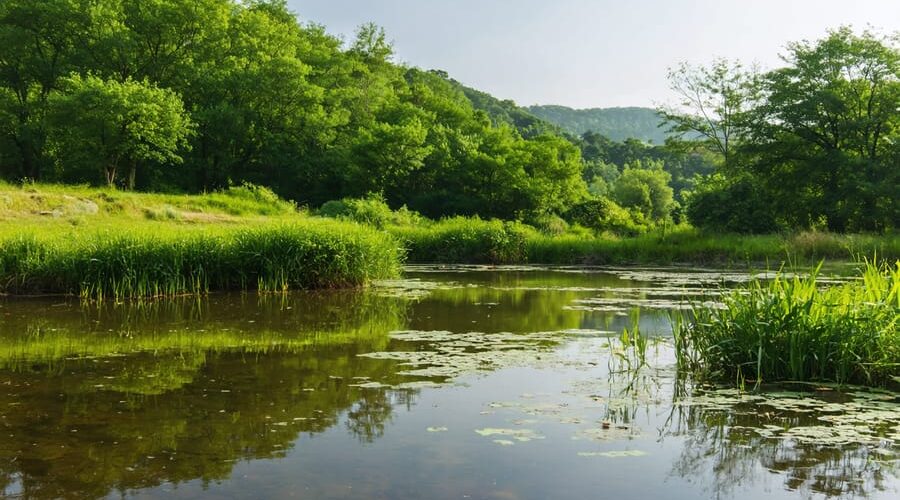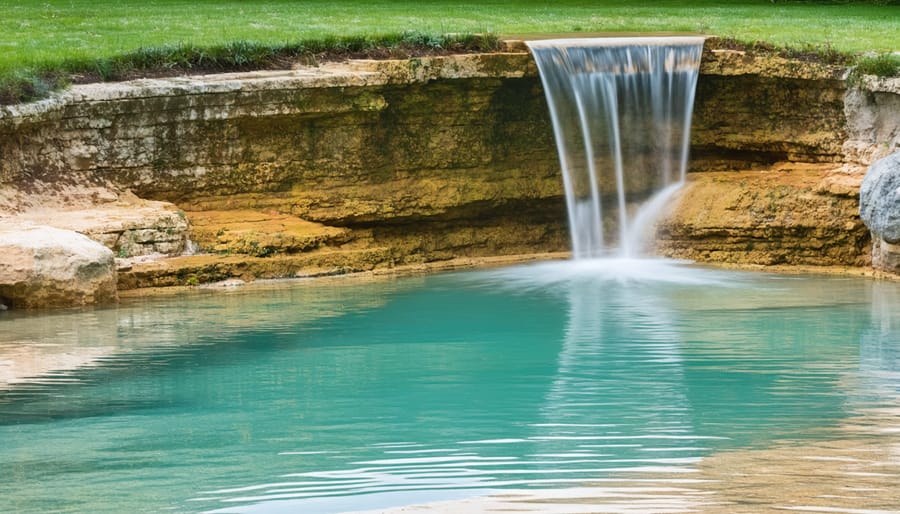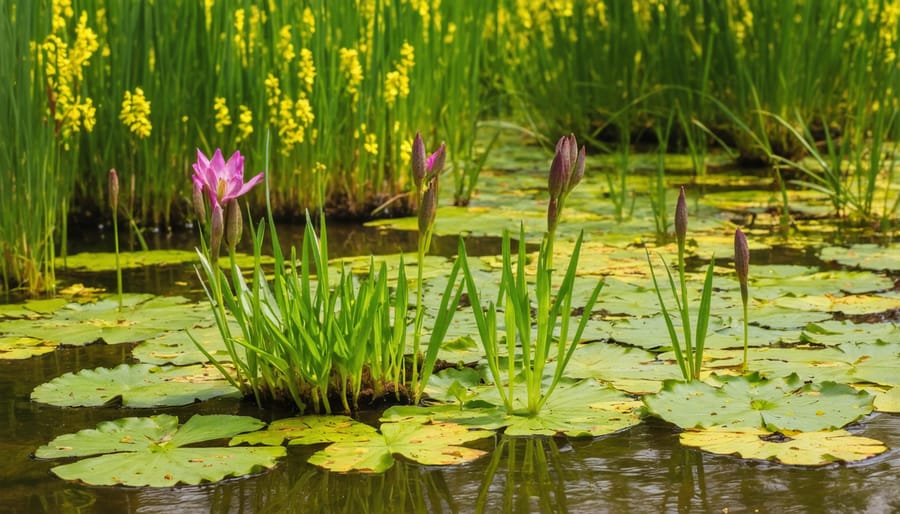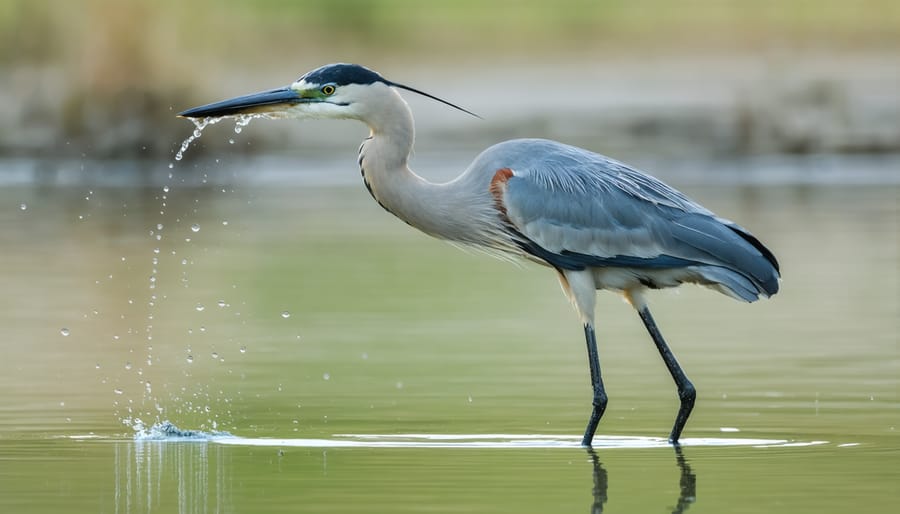
How Groundwater Shapes Your Pond’s Hidden Ecosystem
Beneath every thriving pond lies an invisible network of groundwater that shapes your water garden’s entire ecosystem. Like the roots of a mighty oak, groundwater systems quietly sustain life while remaining hidden from view. Understanding this underground water dance isn’t just fascinating – it’s essential for creating and maintaining a healthy pond habitat.
Think of groundwater as your pond’s silent partner, continuously exchanging water through soil layers and affecting everything from water levels to plant health. Whether you’re planning a new water feature or maintaining an existing pond, the way groundwater moves through your landscape directly impacts your success as a pond keeper.
In this guide, we’ll explore how groundwater influences your pond’s ecosystem and share practical strategies for working with these natural water patterns. You’ll discover why some ponds stay naturally full while others need constant topping up, and learn how to harness groundwater’s benefits while avoiding common pitfalls that can compromise your pond’s health.
For both novice pond owners and experienced water gardeners, understanding groundwater hydrology is the key to creating a more resilient and self-sustaining water feature that brings joy for years to come. Let’s dive into the fascinating world beneath your pond’s surface.
Understanding Your Pond’s Groundwater Connection
Natural Springs and Seepage
Natural springs occur when groundwater finds its way to the surface, creating magical spots where fresh, clean water bubbles up from underground aquifers. These springs aren’t just beautiful features in the landscape – they’re vital water sources that feed ponds, streams, and create unique microhabitats teeming with life.
When groundwater seeps through soil and rock layers, it can emerge in different ways. Sometimes it creates visible springs where water flows freely, while other times it appears as subtle seepage areas that keep the soil consistently moist. These seepage zones are particularly special because they maintain steady water temperatures and mineral content throughout the year, supporting specialized plants and animals that rely on these stable conditions.
For pond owners, natural springs can be a blessing, providing a constant supply of fresh water that helps maintain healthy water levels and water quality. The steady flow helps prevent stagnation and introduces beneficial minerals that support aquatic life. Even small seepage areas around your pond can create perfect spots for moisture-loving plants and attract diverse wildlife to your water garden.

Water Table Fluctuations
Water table fluctuations are a natural part of pond life that every pond owner should understand. Throughout the year, you’ll notice changes in your pond’s water level that correspond with seasonal patterns. During spring, melting snow and increased rainfall typically raise the water table, which can lead to higher pond levels and improved water quality. Conversely, summer months often bring lower water tables due to increased evaporation and reduced rainfall.
These seasonal changes significantly impact your pond’s ecosystem. Higher water tables in spring help flush out accumulated nutrients and provide fresh water to your pond, supporting new growth and aquatic life. During drier periods, lower water tables might concentrate nutrients and reduce oxygen levels, potentially stressing fish and plants.
To maintain a healthy pond environment, monitor your water levels regularly and consider installing a water level indicator. If you notice significant drops, especially during summer, you may need to add water to maintain proper depth for your aquatic life. Adding aquatic plants that thrive in varying water depths can help your pond adapt to these natural fluctuations while maintaining its beauty and ecological balance.
Enhancing Biodiversity Through Groundwater Management
Creating Groundwater-Fed Zones
Creating groundwater-fed zones in your pond can enhance its natural appeal and support diverse aquatic life. Start by identifying areas where groundwater naturally seeps into your property – these spots often feel damp or soggy even during dry spells. These locations are perfect for establishing groundwater entry points.
To create a groundwater-fed zone, dig a graduated slope starting from the identified seepage point. The slope should gently descend toward your pond, with a gradient of about 1:3 (one foot drop for every three feet of horizontal distance). Line the slope with a layer of coarse gravel, followed by progressively finer materials like pea gravel and sand. This natural filtration system helps clean the groundwater as it flows into your pond.
Consider installing a few large rocks or boulders along the slope to create mini-cascades. These not only look attractive but also help aerate the water as it flows. Plant moisture-loving native species along the margins to help stabilize the soil and create natural habitat zones.
Maintain your groundwater-fed areas by regularly checking for debris buildup and clearing any blocked channels. During seasonal cleanups, avoid disturbing the natural flow patterns that develop over time. If you notice any stagnant areas, adjust the slope slightly or add more drainage material to improve flow.
Remember that these zones may flow more strongly during wet seasons and reduce or stop during dry spells – this is completely natural and helps create dynamic pond conditions that mirror natural ecosystems.
Plant Selection for Seepage Areas
Choosing the right plants for seepage areas can transform challenging wet spots into vibrant garden features. These naturally moist areas are perfect for creating stunning displays with native wetland plants that thrive in damp conditions.
For consistently wet areas, consider moisture-loving plants like Japanese Iris, which produces stunning purple blooms, or the adaptable Rush (Juncus), which adds vertical interest with its distinctive stems. Marsh Marigolds are another excellent choice, offering cheerful yellow flowers in spring while helping to stabilize wet soil.
If your seepage area experiences fluctuating moisture levels, opt for versatile plants like Swamp Milkweed, which attracts butterflies, or Joe-Pye Weed, which produces lovely pink flower clusters. These plants can handle both wet and moderately dry conditions, making them perfect for variable groundwater levels.
For ground cover in seepage areas, consider Creeping Jenny or Golden Creeping Jenny, which spreads beautifully and creates a carpet of yellow-green foliage. Cardinal Flower adds dramatic red spikes that hummingbirds absolutely love, while Cattails provide natural filtering properties and create habitat for wildlife.
Remember to group plants with similar water needs together and consider their mature sizes when planning your layout. This thoughtful approach will create a low-maintenance, naturally beautiful solution for those tricky wet spots in your landscape.

Supporting Aquatic Wildlife
Groundwater plays a vital role in supporting aquatic wildlife, creating unique ecosystems that benefit countless species. These underground water systems form natural habitats that many creatures depend on for survival. In your pond, proper groundwater management can create the perfect environment for native fish, amphibians, and helpful insects.
Small fish like minnows thrive in groundwater-fed ponds because of the consistent temperature and clean water supply. Frogs and salamanders particularly love these environments, using the stable conditions for breeding and shelter. You’ll often spot dragonflies and damselflies zipping around, as they’re drawn to the crystal-clear water that good groundwater flow provides.
The natural filtration process of groundwater helps maintain optimal conditions for underwater plants, which in turn provide food and shelter for various creatures. Water-loving birds like herons and kingfishers are frequent visitors to healthy groundwater-fed ponds, adding another layer of wildlife diversity to your backyard ecosystem.
Crayfish and freshwater shrimp often establish themselves in areas where groundwater seeps create small pools, helping to clean the water and recycle nutrients. Even microscopic organisms benefit from the mineral-rich groundwater, forming the base of a healthy aquatic food chain that supports larger species.
To maximize wildlife benefits, maintain natural groundwater flow patterns and avoid excessive water extraction, ensuring your pond remains a haven for local wildlife throughout the year.

Common Groundwater Challenges
Managing Water Quality
Managing water quality from groundwater sources is crucial for maintaining a healthy pond ecosystem. When groundwater enters your pond, it often brings dissolved minerals and can have varying pH levels that need careful monitoring and adjustment.
Groundwater typically contains higher levels of dissolved minerals like calcium, magnesium, and iron compared to surface water. While some minerals are beneficial for aquatic life, excessive amounts can lead to water hardness issues and affect plant growth. Regular testing with a basic water quality kit can help you track these levels.
The pH of groundwater can vary significantly depending on your local geology. Most groundwater tends to be slightly acidic, with pH levels between 6 and 8.5. For optimal pond health, aim to maintain a pH between 6.8 and 7.8. You can adjust pH levels naturally using limestone for increasing pH or peat moss for decreasing it.
To manage mineral content effectively:
– Install a pre-filter system to remove excess iron and other minerals
– Use water plants that naturally absorb excess minerals
– Perform partial water changes if mineral levels become too high
– Consider installing an aerator to help precipitate excess minerals
Remember that groundwater quality can change seasonally, so establish a regular testing schedule. If you notice unusual water coloration or unexpected plant growth patterns, test your water quality immediately. This proactive approach helps maintain a balanced aquatic environment your pond inhabitants will thrive in.
Controlling Erosion
Groundwater erosion can be a serious concern for pond owners, but with the right approach, you can protect your water feature and surrounding landscape. Understanding how natural water flow patterns affect your property is the first step in preventing erosion damage.
Start by installing proper drainage systems around your pond. French drains are particularly effective at redirecting excess groundwater away from vulnerable areas. Place these drains strategically uphill from your pond to intercept water before it becomes problematic.
Vegetation plays a crucial role in erosion control. Plant deep-rooted native species around your pond’s edges and on surrounding slopes. Their root systems help bind the soil together while absorbing excess water. Consider using moisture-loving plants like rushes and sedges along the pond’s edge, and drought-resistant groundcovers on higher ground.
Adding riprap or stone barriers in areas where water tends to concentrate can help dissipate its erosive force. Layer different sizes of stone, with larger rocks at the bottom and smaller ones on top, to create a natural-looking barrier that’s both functional and attractive.
Regular monitoring is essential. Watch for signs of soil movement, such as small channels forming or exposed roots. Address these issues early by adding additional plants or adjusting your drainage system to prevent major damage from developing.
Seasonal Maintenance Tips
Maintaining your groundwater-influenced pond requires different approaches throughout the year. Let’s break down the essential tasks by season to keep your pond healthy and beautiful all year round.
Spring (March-May):
As the weather warms up, test your water quality and pH levels. Spring rains can affect groundwater levels, so monitor your pond’s depth and adjust your pump settings if needed. Remove any dead plants or debris that accumulated over winter, and trim back emerging vegetation. This is also the perfect time to check your liner for winter damage and repair any issues.
Summer (June-August):
Hot weather increases evaporation, which can concentrate minerals from groundwater. Keep an eye on water levels and top up when necessary, preferably with collected rainwater. Install shade plants to reduce algae growth and maintain cooler water temperatures. Clean filters more frequently, as biological activity peaks during this season.
Fall (September-November):
Prepare your pond for winter by removing fallen leaves before they sink and decay. If you have a skimmer, clean it regularly during this period. Consider installing a pond net to catch falling leaves. Fall is also ideal for testing groundwater influence by measuring seepage rates when rainfall is minimal.
Winter (December-February):
Don’t break ice on your pond surface – this can shock fish and damage the ecosystem. Instead, use a floating de-icer if needed. Reduce feeding and maintenance but maintain essential filtration. Monitor water levels, as frozen ground can affect groundwater seepage.
Year-round tips:
– Keep records of water level fluctuations to understand your pond’s groundwater patterns
– Maintain a buffer zone of native plants around the pond to filter runoff
– Check pump performance monthly
– Test water quality quarterly
– Watch for signs of excessive groundwater influence like constant overflow or mineral buildup
By following these seasonal guidelines, you’ll maintain a healthy balance between groundwater input and your pond’s ecosystem, creating a thriving water feature that brings year-round enjoyment.
Understanding and working with groundwater patterns is essential for creating a thriving pond ecosystem. As we’ve explored throughout this article, groundwater plays a vital role in maintaining water levels, supporting plant life, and creating sustainable water features in your garden.
Remember that groundwater is nature’s own irrigation system, moving slowly but steadily through soil layers and feeding our water features. By working with these natural patterns rather than against them, you can create more sustainable and lower-maintenance water gardens that flourish year-round.
Consider mapping the natural water flow in your yard before starting any pond project. Pay attention to where water naturally collects after rain and which areas tend to stay moist longer. These observations can help you position your pond where it will benefit most from natural groundwater movement.
Don’t forget that healthy groundwater systems support local wildlife and contribute to a more diverse garden ecosystem. By maintaining proper drainage and avoiding harmful chemicals, you’re not just helping your pond – you’re supporting the entire local environment.
Take time to observe, plan, and work alongside nature’s own water systems. Whether you’re building a new pond or maintaining an existing one, understanding groundwater hydrology will help you create a more beautiful, sustainable, and thriving water feature that brings joy for years to come.
